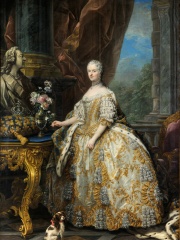

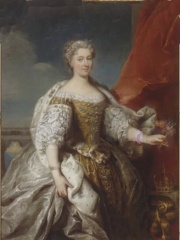
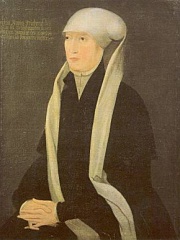
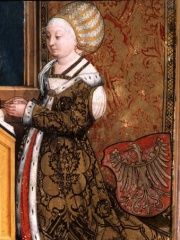
The Most Famous
COMPANIONS from Poland
This page contains a list of the greatest Polish Companions. The pantheon dataset contains 784 Companions, 6 of which were born in Poland. This makes Poland the birth place of the 23rd most number of Companions behind Ukraine, and Netherlands.
Top 6
The following people are considered by Pantheon to be the most legendary Polish Companions of all time. This list of famous Polish Companions is sorted by HPI (Historical Popularity Index), a metric that aggregates information on a biography's online popularity.

1. Marie Leszczyńska (1703 - 1768)
With an HPI of 77.24, Marie Leszczyńska is the most famous Polish Companion. Her biography has been translated into 46 different languages on wikipedia.
Marie Leczinska (born Maria Karolina Zofia Felicja Leszczyńska; 23 June 1703 – 24 June 1768) was Queen of France as the wife of King Louis XV from their marriage on 4 September 1725 until her death in 1768. The daughter of Stanislaus I Leszczyński, the deposed King of Poland, and Catherine Opalińska, her 42-years and 9 months service was the longest of any queen in French history. A devout Catholic throughout her life, Marie was popular among the French people for her numerous charitable works and introduced many Polish customs to the royal court at Versailles. She was the grandmother of the French kings Louis XVI, Louis XVIII and Charles X.

2. Maria Feodorovna (1759 - 1828)
With an HPI of 69.69, Maria Feodorovna is the 2nd most famous Polish Companion. Her biography has been translated into 38 different languages.
Maria Feodorovna (Russian: Мария Фёдоровна; Sophie Marie Dorothea Auguste Luise; 25 October 1759 – 5 November 1828 [OS 24 October]) became Empress of Russia as the second wife of Emperor Paul I. She founded the Office of the Institutions of Empress Maria. Daughter of Duke Frederick Eugene of Württemberg and Princess Friederike of Brandenburg-Schwedt, Sophie Dorothea belonged to a junior branch of the House of Württemberg and grew up in Montbéliard, receiving an excellent education for her time. After Grand Duke Paul (the future Paul I of Russia) became a widower in 1776, King Frederick II of Prussia (Sophie Dorothea's maternal great-uncle) and Empress Catherine II of Russia chose Sophie Dorothea as the ideal candidate to become Paul's second wife. In spite of her fiancé's difficult character, she developed a long, peaceful relationship with Paul and converted to the Russian Orthodox Church in 1776, adopting the name Maria Feodorovna. During the long reign (1762–1796) of her mother-in-law, she sided with her husband and lost the initial affection the reigning Empress had for her. The couple were completely excluded from any political influence, as mother and son mistrusted each other. They were forced to live in isolation at Gatchina Palace, where they had many children together. After her husband ascended the Russian throne in 1796, Maria Feodorovna had a considerable and beneficial influence during his four-year reign. On the night of Paul I's assassination (23 March [O.S. 11 March] 1801), she thought to imitate her mother-in-law's example and claim the throne, but her son, the future Emperor Alexander I, dissuaded her. She instead instituted the precedence whereby the Empress dowager out-ranked the reigning monarch's wife, a system unique to the Russian court. Clever, purposeful and energetic, Maria Feodorovna founded and managed all the Russian Empire's charitable establishments, re-modelled the palaces of Gatchina and Pavlovsk, and encouraged foreign links directed against Napoleon I of France. She often gave political counsel to her children, who held her in great respect. The imperial family deeply mourned her death, and her successors regarded her as a role model.

3. Catherine Opalińska (1680 - 1747)
With an HPI of 67.99, Catherine Opalińska is the 3rd most famous Polish Companion. Her biography has been translated into 27 different languages.
Countess Catherine Opalińska (Polish: Katarzyna Opalińska; 13 October 1680 – 19 March 1747), was by birth member of House of Opaliński, Queen consort and Grand Duchess consort of the Polish–Lithuanian Commonwealth twice and Duchess consort of Lorraine through her marriage with Stanisław I of Poland and Lithuania. Born into the Polish aristocratic family of Opaliński, Catherine married Stanisłaus Leszczyński in 1698 and six years later he was elected as King of Poland and Grand Duke of Lithuania, due to the support of Charles XII of Sweden where she repaid this favour by favouring Swedish people at court. In 1708 Catherine was sent to Stettin due to the increasingly unstable political environment and a year later her husband was deposed due to the loss of Swedish dominance in the Commonwealth; and she and her family were exiled to Sweden and were welcomed by the dowager queen, Hedwig and they became popular members of high society. In 1714 they moved to the Swedish ruled town of Zweibrücken where they were supported by the state. However, after the death of Charles in 1718 they moved to Wissembourg where the family were subjected to cramped conditions and because of this Catherine began feeling annoyance towards her husband but in 1725 their only surviving child, Maria, married the King of France, which was massive upgrade in status. In 1733 Stanisłaus was restored to the Polish-Lithuanian throne during the War of Polish Succession, thanks to French support, but only three years later he abdicated. The peace treaty made Catherine Duchess of Lorraine but her husband had to give up rights to the Polish-Lithuanian throne. She never fully adjusted to life in Lorraine and always longed for Poland-Lithuania but suffered from ill health, which hindered her opportunities to attend court. Upon their arrival Stanisłaus immediately began taking up mistresses which most of the time, came from her household. Catherine died on 19 March 1747 and a grand funeral service was staged by her son-in-law at Notre Dame.

4. Sophie of Pomerania (1498 - 1568)
With an HPI of 65.70, Sophie of Pomerania is the 4th most famous Polish Companion. Her biography has been translated into 26 different languages.
Sophie of Pomerania (1498 – 13 May 1568) was Queen of Denmark and Norway as the second wife of Frederick I. She is known for her independent rule over her fiefs Lolland and Falster, the castles in Kiel and Plön, and several villages in Holstein as queen.
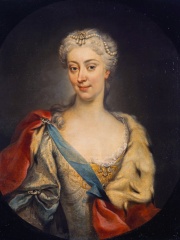
5. Maria Clementina Sobieska (1702 - 1735)
With an HPI of 64.60, Maria Clementina Sobieska is the 5th most famous Polish Companion. Her biography has been translated into 22 different languages.
Maria Clementina Sobieska (Polish: Maria Klementyna Sobieska; 18 July 1702 – 18 January 1735) was a titular queen of England, Scotland, and Ireland by marriage to James Francis Edward Stuart, a Jacobite claimant to the thrones of the British Isles. A granddaughter of the Polish king John III Sobieski, she was the mother of Charles Edward Stuart ("Bonnie Prince Charlie") and of Henry Benedict Cardinal Stuart (Jacobite Duke of York, later Jacobite claimant).

6. Sophia Jagiellon, Margravine of Brandenburg-Ansbach (1464 - 1512)
With an HPI of 61.61, Sophia Jagiellon, Margravine of Brandenburg-Ansbach is the 6th most famous Polish Companion. Her biography has been translated into 17 different languages.
Sophia Jagiellon (Polish: Zofia Jagiellonka; Lithuanian: Sofija Jogailaitė; 6 May 1464 – 5 October 1512) was a princess of the Kingdom of Poland and of the Grand Duchy of Lithuania, member of the Jagiellonian dynasty, great-granddaughter of Emperor Sigismund and by marriage Margravine of Brandenburg-Ansbach and Brandenburg-Kulmbach. Born in Kraków, she was the second daughter of Grand Duke of Lithuania and King Casimir IV of Poland and his wife Archduchess Elisabeth of Austria, daughter of the German king Albrecht. She was named after her paternal grandmother, Sophia of Halshany, Queen of Poland. Sophia was baptised by John Gruszczynski, Bishop of Kraków. There is no information available concerning Sophia's upbringing or education.
People
Pantheon has 6 people classified as Polish companions born between 1464 and 1759. Of these 6, none of them are still alive today. The most famous deceased Polish companions include Marie Leszczyńska, Maria Feodorovna, and Catherine Opalińska.
Deceased Polish Companions
Go to all RankingsMarie Leszczyńska
1703 - 1768
HPI: 77.24
Maria Feodorovna
1759 - 1828
HPI: 69.69
Catherine Opalińska
1680 - 1747
HPI: 67.99
Sophie of Pomerania
1498 - 1568
HPI: 65.70
Maria Clementina Sobieska
1702 - 1735
HPI: 64.60
Sophia Jagiellon, Margravine of Brandenburg-Ansbach
1464 - 1512
HPI: 61.61
Overlapping Lives
Which Companions were alive at the same time? This visualization shows the lifespans of the 3 most globally memorable Companions since 1700.

